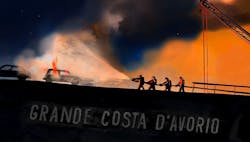'Flaming Fireballs' Man Recalls Jeep Fire Aboard Ship
nj.com
(TNS)
It was a typical workday on the docks for Gavin Puchinsky on the night that the freighter, the Grande Costa d’Avorio, caught fire.
Puchinksy was a “lasher.” His job was to get cars on the 692-foot freighter and secure or lash them to the deck before the ship set sail with its cargo of 1,200 aging and junked vehicles for West Africa. He was behind the wheel of a yellow, 16-year-old Jeep Wrangler he was using to push an inoperable Toyota SUV being steered by his partner up the ramp to Deck 10 when he heard a loud clunk, like a wrench being dropped to the floor.
“I didn’t pay any attention to it. There was a lot of noise,” said the 20-year-old longshoreman who worked at Port Newark.
As the Toyota rolled into place, he sat in the two-door Jeep with its windows open, when people suddenly started screaming at him to get out of the vehicle because it was on fire.
“I turned to my right and flames were coming in through the passenger window,” he said. “It looked like it was coming out of the hood and into the passenger side of the car.”
Underneath, he recalled seeing what looked like “flaming fireballs dripping from the bottom of the vehicle.”
Soon, black smoke began filling the sprawling cargo compartment.
Video showing the yellow Jeep pushing a vehicle aboard the Grande Costa d’Avorio on the night of the fire.
Puchinsky offered the first eyewitness account of the moments leading up to the fatal fire aboard the car-carrying ship on July 5, as the U.S. Coast Guard on Wednesday began a series of hearings into what happened, and why. The blaze led to the deaths of two Newark firefighters after they became lost and trapped between vehicles parked just inches apart.
Coast Guard Cmdr. Christian Barger, the lead investigator, has called the ongoing fact-finding inquiry a complex effort that will examine the handling procedures the loading of cargo, the initial response actions by the ship’s crew, and the ill-fated efforts by the Newark Fire Department to get it under control.
The hearings, being held at the Union Township City Council Chambers in Union County, are being livestreamed at: https://livestream.com/uscginvestigations.
The proceedings on Wednesday opened with moment of silence for the late firefighters, Augusto “Augie” Acabou, 45, and Wayne “Bear” Brooks Jr., 49, who were found on Deck 10 as they attempted to track down the source of the fire after the Newark Fire Department arrived on scene. Family members of both men attended the hearing, listening intently to the testimony.
In later hearings, top command officers of the city’s fire department will be also called to address the panel, which included members of the Coast Guard investigative team and the National Transportation Safety Board. But the focus of the first day was the Jeep that sparked the fire.
Austin Costanzo, another lasher who like Puchinsky worked for American Maritime Services of New York, had been working the ship loading process on July 5 as part of the team of longshoremen. He said he had been directly behind Puchinsky in another pusher vehicle that evening. He did not see the fire start, but he testified that he had had experience with the same Jeep, recounting overheating problems in the past.
“It would blink a yellow light that said engine oil,” he said. “When it overheated, I’d pull it to the side and get another vehicle.”
But he testified there was no process to let other longshoremen know that any vehicle was having problems, other than to park it to the side and let it cool down.
“Which means ‘don’t use it, something is wrong,’” he told the hearing officers.
But parking to the side could also mean it was low on fuel or other issues beyond overheating.
Who would clear the vehicle for use?
He shrugged. “I don’t know,” he responded.
Asked if he had ever experienced a puncture of the radiator, he again had no answer.
“I’m not sure,” he replied. “I’m not a mechanic.”
The testimony, though, backed up allegations by the families of the two firefighters who perished that the Jeep had sparked the blaze that led to their deaths. Neither man, however, acknowledged statements made by crew members in the wake of the fire that the vehicle had been having mechanical problems earlier in the day.
In fact, Puchinsky said he had not been aware if the Jeep had been experiencing problems. However, he did notice it had been sent to the side before Puchinsky got into it shortly after lunchtime.
An introductory video presented by the Coast Guard as the hearings began offered images of the burned-out deck emptied of many of the vehicles that had been destroyed, wrecked and resting on burst tires. The Jeep was there as well, largely intact, with a discharged red fire extinguisher dropped on the deck nearby.
Puchinsky said he had grabbed a fire extinguisher from the wall of the compartment after bailing out of the Jeep.
“I was aiming underneath where the fireballs were coming,” he said. “Crew members started grabbing fire extinguishers. I finished mine and threw it down. Grabbed another one.”
But as the fire spread, others said he had to leave.
“Come on! We have to get off the ship!” he remembered. “Everything happened in seconds.”
As the smoke continued to build, he went down the ramp.
“I knew I couldn’t stay there,” he said.
The hearings continue Thursday with several of the ship’s officers scheduled to testify, including Capt. Capt. Alessandro Moretti, the master of the Grande Costa d’Avorio.
__
Local journalism needs your support. Subscribe at nj.com/supporter.
Ted Sherman may be reached at [email protected]. Follow him on Twitter @TedShermanSL
©2024 Advance Local Media LLC. Visit nj.com. Distributed by Tribune Content Agency, LLC.
